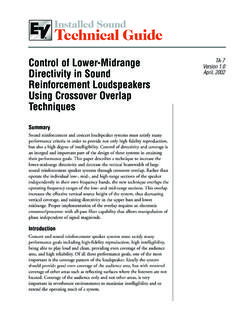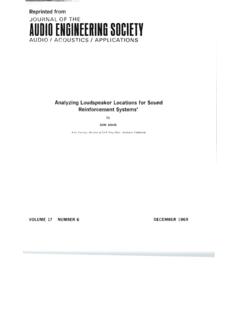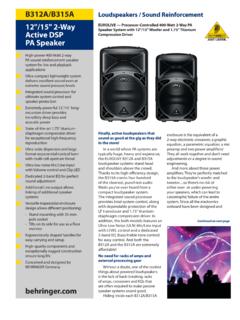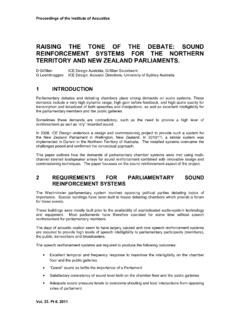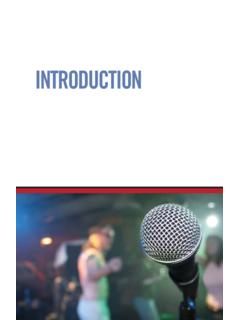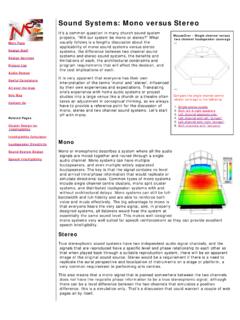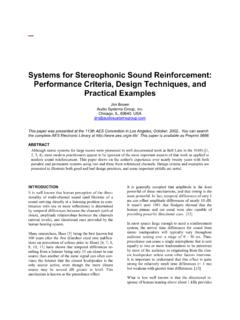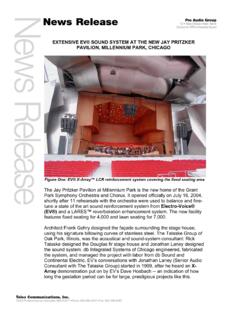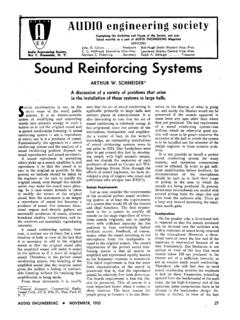Transcription of ODEON APPLICATION NOTE Calculation of Speech …
1 APPLICATION note Calculation of STI in rooms 1 ODEON APPLICATION NOTE Calculation of Speech Transmission Index in rooms JHR, February 2014 Scope Sufficient acoustic quality of Speech communication is very important in many different situations and places; classrooms in schools, auditoria, PA systems in public buildings, alert and warning systems in noisy environments etc. Speech transmission index (STI) is an objective method for prediction and measurement of Speech intelligibility. This is a guide how to use ODEON for calculating the Speech transmission index in a room in accordance with the international standards IEC 60268-16 [1] and ISO 9921 [2].
2 This APPLICATION note is not applicable for open-plan offices, which are dealt with in another ODEON APPLICATION note1. This APPLICATION note refers to ODEON version 12, all editions. Method Although IEC 60268-16 is a measurement method, the measurement procedure can be simulated in ODEON , thus providing a tool for the acoustical design of performance spaces and other rooms where Speech communication is important, or for the design of a loudspeaker system in a room. Two different types of cases will be discussed: Direct communication between two people in the same environment and public address (PA) systems where an electro-acoustic system is used to address a group of people.
3 The original method [1] is based on a special modulated Speech -shaped signal and the measurement of modulation transfer functions in seven octave bands with 14 different modulation frequencies. However, an alternative and equally good method uses the impulse response as suggested by Schroeder [3]. This so-called indirect method is the one used in ODEON . Terms and definitions Ambient noise Noise due to all other sound sources than the communication Speech . Background noise level sound pressure level in octave bands due to ambient noise, spatially averaged over the relevant listener area.
4 1 APPLICATION note Calculation of STI in rooms 2 Public address system PA Electro-acoustic system used to address a group of people. Reference Speech level Speech level equivalent to 60 dB(A) at 1 m distance in front of the talker s mouth. Signal-to-noise ratio SNR Difference between the sound pressure level of the Speech or test signal and the sound pressure level of the background noise. Speech intelligibility Rating of the proportion of Speech that is understood.
5 Speech transmission index STI Objective method for prediction and measurement of Speech intelligibility. Rapid Speech transmission index RASTI A simplified and approximate measurement method for rating Speech transmission in auditoria, with or without sound systems. NOTE 1: RASTI was defined in IEC 268-16:1988. NOTE 2: RASTI is obsolete and should not be used any more. Speech transmission index for PA STIPA A condensed and approximate version of the STI measurement method for PA systems. NOTE: STIPA is only applied as a direct method, not relevant for the indirect method used in simulations.
6 STI (expected) Value of STI calculated from the reverberation time and assuming an ideal exponential decay of energy. NOTE: Due to direct sound and beneficial early reflections STI will normally be greater than STI (expected). So a comparison of the actual STI with STI(expected) can reveal the quality of the acoustic design in the room. If STI is greater than STI(expected) then the design is considered better that if the room was totally diffuse. Tapping Is the process of adjusting the electric power applied to a constant-voltage speaker system, by connecting various input taps to the step-down transformer.
7 The adjustment of the electric power leads to an adjustment of the sound power emitted by the loudspeaker unit. Vocal effort Characterisation of the sound level emitted by a human speaker, quantified objectively by the A-weighted Speech level at 1 m distance in front of the mouth and qualified subjectively by a description. APPLICATION note Calculation of STI in rooms 3 Voice alarm system VA Electro-acoustic system used to broadcast Speech messages or warning signals in an emergency. sound sources Three different types of sound source are considered in this APPLICATION note, a human speaker, a sound reinforcement loudspeaker system and a constant-voltage speaker system, also called a high-voltage audio distribution system.
8 The case of a human speaker applies to class rooms, meeting rooms and small auditoria. The Speech level and Speech spectrum have to be chosen according to the preconditions for the room. Cases where the sound source is one or more loudspeakers include auditoria, concert halls and stadiums. The constant-voltage speaker systems are typically applied in public areas, shopping centres, railway stations, airports. Other important applications are voice alarm (VA) systems in noisy working places, off-shore installations. Human speakers The important acoustical parameters for a sound source representing a human speaker are the Speech level and the directivity, both given in octave bands.
9 The source for generalised Speech level data is the American Standard ANSI [4], which has data representing four different levels of vocal effort; normal, raised, loud, and shouted, see Table 1. The directivity of human speakers is available from a Canadian study [5]. In this research report several factors were investigated, and it is concluded that the directivity is not significantly affected by vocal effort, gender, or language (English or French). Among the predefined sound sources in ODEON you will find two that are relevant to this APPLICATION : and The name of the source files reflect the fact that these sources are as defined in the Calculation guidance to the British Building Bulletin 93 [6].
10 The data at the 125 Hz octave band are not available from ANSI but are required for the STI calculations, and thus the Speech level at 125 Hz has been chosen to be 6 dB lower than the 250 Hz level. The original data for Speech level are given as sound pressure levels (SPL) at a distance of 1 m in front of the speaker s lips in the free field. This kind of data is relevant for a communication system where a microphone is placed in front of the speaker. However, for room acoustic applications it is more useful to define the sound source by the radiated sound power.

